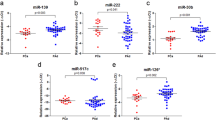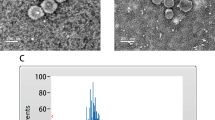Abstract
Inherited, germline mutations of menin-coding MEN1 gene cause multiple endocrine neoplasia type 1 (MEN1), while somatic MEN1 mutations are the sole main driver mutations in sporadic primary hyperparathyroidism (PHPT), suggesting that menin deficiency has a central role in the pathogenesis of PHPT. MiRNAs are small, noncoding RNAs posttranscriptionally regulating gene expression. Our aim was to investigate both the role of MEN1 mutations and potentially MEN1-targeting miRNAs as the underlying cause of menin deficiency in MEN1-associated and sporadic PHPT tissues. Fifty six PHPT tissues, including 16 MEN1-associated tissues, were evaluated. Diagnosis of MEN1 syndrome was based on identification of germline MEN1 mutations. In silico target prediction was used to identify miRNAs potentially targeting MEN1. Menin expression was determined by immunohistochemistry while expression of miRNAs was analyzed by quantitative real-time PCR. Sporadic PHPT tissues were subjected to somatic MEN1 mutation analysis as well. Lack of nuclear menin was identified in all MEN1-associated and in 28% of sporadic PHPT tissues. Somatic MEN1 mutations were found in 25% of sporadic PHPTs. The sensitivity and specificity of menin immunohistochemistry to detect a MEN1 mutation were 86 and 87%, respectively. Expression levels of hsa-miR-24 and hsa-miR-28 were higher in sporadic compared to MEN1-associated PHPT tissues; however, no difference in miRNA levels occurred between menin-positive and menin-negative PHPT tissues. Menin deficiency is the consequence of a MEN1 mutation in most menin-negative PHPT tissues. Elevated expression of hsa-miR-24 and hsa-miR-28 mark the first epigenetic changes observed between sporadic and MEN1-associated PHPT.



Similar content being viewed by others
References
Fraser WD (2009) Hyperparathyroidism. Lancet 374(9684):145–158. doi:10.1016/S0140-6736(09)60507-9
Carlson D (2010) Parathyroid pathology: hyperparathyroidism and parathyroid tumors. Arch Pathol Lab Med 134(11):1639–1644. doi:10.1043/2009-0578-CCR.1
Grey A (2012) Nonsurgical management of mild primary hyperparathyroidism—a reasonable option. Clin Endocrinol 77(5):639–644. doi:10.1111/j.1365-2265.2012.04501.x
Alvelos MI, Vinagre J, Fonseca E, Barbosa E, Teixeira-Gomes J, Sobrinho-Simoes M, Soares P (2013) MEN1 intragenic deletions may represent the most prevalent somatic event in sporadic primary hyperparathyroidism. Eur J Endocrinol 168(2):119–128. doi:10.1530/EJE-12-0327
Newey PJ, Nesbit MA, Rimmer AJ, Attar M, Head RT, Christie PT, Gorvin CM, Stechman M, Gregory L, Mihai R, Sadler G, McVean G, Buck D, Thakker RV (2012) Whole-exome sequencing studies of nonhereditary (sporadic) parathyroid adenomas. J Clin Endocrinol Metab 97(10):E1995–E2005. doi:10.1210/jc.2012-2303
Westin G, Bjorklund P, Akerstrom G (2009) Molecular genetics of parathyroid disease. World J Surg 33(11):2224–2233. doi:10.1007/s00268-009-0022-6
Sharretts JM, Simonds WF (2010) Clinical and molecular genetics of parathyroid neoplasms. Best Pract Res Clin Endocrinol Metab 24(3):491–502. doi:10.1016/j.beem.2010.01.003
Romero Arenas MA, Fowler RG, San Lucas FA, Shen J, Rich TA, Grubbs EG, Lee JE, Scheet P, Perrier ND, Zhao H (2014) Preliminary whole-exome sequencing reveals mutations that imply common tumorigenicity pathways in multiple endocrine neoplasia type 1 patients. Surgery 156(6):1351–1357; discussion 1357-1358. doi:10.1016/j.surg.2014.08.073
Igaz P (2009) MEN1 clinical background. Adv Exp Med Biol 668:1–15
Cromer MK, Starker LF, Choi M, Udelsman R, Nelson-Williams C, Lifton RP, Carling T (2012) Identification of somatic mutations in parathyroid tumors using whole-exome sequencing. J Clin Endocrinol Metab 97(9):E1774–E1781. doi:10.1210/jc.2012-1743
Verdelli C, Forno I, Vaira V, Corbetta S (2015) Epigenetic alterations in human parathyroid tumors. Endocrine 49(2):324–332. doi:10.1007/s12020-015-0555-4
Valencia-Sanchez MA, Liu J, Hannon GJ, Parker R (2006) Control of translation and mRNA degradation by miRNAs and siRNAs. Genes Dev 20(5):515–524. doi:10.1101/gad.1399806
Butz H, Liko I, Czirjak S, Igaz P, Korbonits M, Racz K, Patocs A (2011) MicroRNA profile indicates downregulation of the TGFbeta pathway in sporadic non-functioning pituitary adenomas. Pituitary 14(2):112–124. doi:10.1007/s11102-010-0268-x
Tombol Z, Eder K, Kovacs A, Szabo PM, Kulka J, Liko I, Zalatnai A, Racz G, Toth M, Patocs A, Falus A, Racz K, Igaz P (2010) MicroRNA expression profiling in benign (sporadic and hereditary) and recurring adrenal pheochromocytomas. Mod Pathol 23(12):1583–1595. doi:10.1038/modpathol.2010.164
Tombol Z, Szabo PM, Molnar V, Wiener Z, Tolgyesi G, Horanyi J, Riesz P, Reismann P, Patocs A, Liko I, Gaillard RC, Falus A, Racz K, Igaz P (2009) Integrative molecular bioinformatics study of human adrenocortical tumors: microRNA, tissue-specific target prediction, and pathway analysis. Endocr Relat Cancer 16(3):895–906. doi:10.1677/ERC-09-0096
Rahbari R, Holloway AK, He M, Khanafshar E, Clark OH, Kebebew E (2011) Identification of differentially expressed microRNA in parathyroid tumors. Ann Surg Oncol 18(4):1158–1165. doi:10.1245/s10434-010-1359-7
Corbetta S, Vaira V, Guarnieri V, Scillitani A, Eller-Vainicher C, Ferrero S, Vicentini L, Chiodini I, Bisceglia M, Beck-Peccoz P, Bosari S, Spada A (2010) Differential expression of microRNAs in human parathyroid carcinomas compared with normal parathyroid tissue. Endocr Relat Cancer 17(1):135–146. doi:10.1677/ERC-09-0134
Tsang VH, Dwight T, Benn DE, Meyer-Rochow GY, Gill AJ, Sywak M, Sidhu S, Veivers D, Sue CM, Robinson BG, Clifton-Bligh RJ, Parker NR (2014) Overexpression of miR-210 is associated with SDH-related pheochromocytomas, paragangliomas, and gastrointestinal stromal tumours. Endocr Relat Cancer 21(3):415–426. doi:10.1530/ERC-13-0519
Danza K, De Summa S, Pilato B, Carella M, Palumbo O, Popescu O, Paradiso A, Pinto R, Tommasi S (2014) Combined microRNA and ER expression: a new classifier for familial and sporadic breast cancer patients. J Transl Med 12:319. doi:10.1186/s12967-014-0319-6
Balogh K, Hunyady L, Patocs A, Gergics P, Valkusz Z, Toth M, Racz K (2007) MEN1 gene mutations in Hungarian patients with multiple endocrine neoplasia type 1. Clin Endocrinol 67(5):727–734. doi:10.1111/j.1365-2265.2007.02953.x
Detre S, Saclani Jotti G, Dowsett M (1995) A “quickscore” method for immunohistochemical semiquantitation: validation for oestrogen receptor in breast carcinomas. J Clin Pathol 48(9):876–878
Zhuang Z, Vortmeyer AO, Pack S, Huang S, Pham TA, Wang C, Park WS, Agarwal SK, Debelenko LV, Kester M, Guru SC, Manickam P, Olufemi SE, Yu F, Heppner C, Crabtree JS, Skarulis MC, Venzon DJ, Emmert-Buck MR, Spiegel AM, Chandrasekharappa SC, Collins FS, Burns AL, Marx SJ, Lubensky IA et al (1997) Somatic mutations of the MEN1 tumor suppressor gene in sporadic gastrinomas and insulinomas. Cancer Res 57(21):4682–4686
Grolmusz VK, Stenczer B, Fekete T, Szendei G, Patocs A, Racz K, Reismann P (2013) Lack of association between C385A functional polymorphism of the fatty acid amide hydrolase gene and polycystic ovary syndrome. Exp Clin Endocrinol Diabetes 121(6):338–342. doi:10.1055/s-0033-1337941
Szabo PM, Butz H, Igaz P, Racz K, Hunyady L, Patocs A (2013) Minireview: miRomics in endocrinology: a novel approach for modeling endocrine diseases. Mol Endocrinol 27(4):573–585. doi:10.1210/me.2012-1220
Maragkakis M, Reczko M, Simossis VA, Alexiou P, Papadopoulos GL, Dalamagas T, Giannopoulos G, Goumas G, Koukis E, Kourtis K, Vergoulis T, Koziris N, Sellis T, Tsanakas P, Hatzigeorgiou AG (2009) DIANA-microT web server: elucidating microRNA functions through target prediction. Nucleic Acids Res 37(Web Server issue):W273–W276. doi:10.1093/nar/gkp292
Dweep H, Sticht C, Pandey P, Gretz N (2011) miRWalk–database: prediction of possible miRNA binding sites by “walking” the genes of three genomes. J Biomed Inform 44(5):839–847. doi:10.1016/j.jbi.2011.05.002
Enright AJ, John B, Gaul U, Tuschl T, Sander C, Marks DS (2003) MicroRNA targets in Drosophila. Genome Biol 5(1):R1. doi:10.1186/gb-2003-5-1-r1
Krek A, Grun D, Poy MN, Wolf R, Rosenberg L, Epstein EJ, MacMenamin P, da Piedade I, Gunsalus KC, Stoffel M, Rajewsky N (2005) Combinatorial microRNA target predictions. Nat Genet 37(5):495–500. doi:10.1038/ng1536
Grimson A, Farh KK, Johnston WK, Garrett-Engele P, Lim LP, Bartel DP (2007) MicroRNA targeting specificity in mammals: determinants beyond seed pairing. Mol Cell 27(1):91–105. doi:10.1016/j.molcel.2007.06.017
Grolmusz VK, Toth EA, Baghy K, Liko I, Darvasi O, Kovalszky I, Matko J, Racz K, Patocs A (2016) Fluorescence activated cell sorting followed by small RNA sequencing reveals stable microRNA expression during cell cycle progression. BMC Genomics 17. doi:10.1186/S12864-016-2747-6
Luzi E, Marini F, Giusti F, Galli G, Cavalli L, Brandi ML (2012) The negative feedback-loop between the oncomir Mir-24-1 and menin modulates the Men1 tumorigenesis by mimicking the “Knudson’s second hit”. PLoS One 7(6):e39767. doi:10.1371/journal.pone.0039767
Balogh K, Racz K, Patocs A, Hunyady L (2006) Menin and its interacting proteins: elucidation of menin function. Trends Endocrinol Metab: TEM 17(9):357–364. doi:10.1016/j.tem.2006.09.004
Huang SC, Zhuang Z, Weil RJ, Pack S, Wang C, Krutzsch HC, Pham TA, Lubensky IA (1999) Nuclear/cytoplasmic localization of the multiple endocrine neoplasia type 1 gene product, menin. Lab Investig 79(3):301–310
Karges W, Schaaf L, Dralle H, Boehm BO (2002) Clinical and molecular diagnosis of multiple endocrine neoplasia type 1. Langenbeck’s Arch Surg 386(8):547–552. doi:10.1007/s00423-001-0268-4
Thakker RV, Newey PJ, Walls GV, Bilezikian J, Dralle H, Ebeling PR, Melmed S, Sakurai A, Tonelli F, Brandi ML, Endocrine S (2012) Clinical practice guidelines for multiple endocrine neoplasia type 1 (MEN1). J Clin Endocrinol Metab 97(9):2990–3011. doi:10.1210/jc.2012-1230
Corbo V, Dalai I, Scardoni M, Barbi S, Beghelli S, Bersani S, Albarello L, Doglioni C, Schott C, Capelli P, Chilosi M, Boninsegna L, Becker KF, Falconi M, Scarpa A (2010) MEN1 in pancreatic endocrine tumors: analysis of gene and protein status in 169 sporadic neoplasms reveals alterations in the vast majority of cases. Endocr Relat Cancer 17(3):771–783. doi:10.1677/ERC-10-0028
Swarts DR, Scarpa A, Corbo V, Van Criekinge W, van Engeland M, Gatti G, Henfling ME, Papotti M, Perren A, Ramaekers FC, Speel EJ, Volante M (2014) MEN1 gene mutation and reduced expression are associated with poor prognosis in pulmonary carcinoids. J Clin Endocrinol Metab 99(2):E374–E378. doi:10.1210/jc.2013-2782
Vijayaraghavan J, Maggi EC, Crabtree JS (2014) miR-24 regulates menin in the endocrine pancreas. Am J Phys Endocrinol Metab 307(1):E84–E92. doi:10.1152/ajpendo.00542.2013
Giglio S, Cirombella R, Amodeo R, Portaro L, Lavra L, Vecchione A (2013) MicroRNA miR-24 promotes cell proliferation by targeting the CDKs inhibitors p27Kip1 and p16INK4a. J Cell Physiol 228(10):2015–2023. doi:10.1002/jcp.24368
Occhi G, Regazzo D, Trivellin G, Boaretto F, Ciato D, Bobisse S, Ferasin S, Cetani F, Pardi E, Korbonits M, Pellegata NS, Sidarovich V, Quattrone A, Opocher G, Mantero F, Scaroni C (2013) A novel mutation in the upstream open reading frame of the CDKN1B gene causes a MEN4 phenotype. PLoS Genet 9(3):e1003350. doi:10.1371/journal.pgen.1003350
Pardi E, Mariotti S, Pellegata NS, Benfini K, Borsari S, Saponaro F, Torregrossa L, Cappai A, Satta C, Mastinu M, Marcocci C, Cetani F (2014) Functional characterization of a CDKN1B mutation in a Sardinian kindred with multiple endocrine neoplasia type 4 (MEN4). Endocr Connect. doi:10.1530/EC-14-0116
Elston MS, Meyer-Rochow GY, Dray M, Swarbrick M, Conaglen JV (2015) Early onset primary hyperparathyroidism associated with a novel germline mutation in CDKN1B. Case Rep Endocrinol 2015:510985. doi:10.1155/2015/510985
Author information
Authors and Affiliations
Contributions
A.P. conceived the study. V.K.G., K.B., K.R., and A.P. designed research. V.K.G. and A.P. performed in silico analysis. K.Ba., B.S., A.S., É.Cs., Zs.V., M.T., P.I., and K.R. evaluated patients. V.K.G., A.Kö., K.N., K.Ba., and A.P. performed genetic screening. K.B., C.D., and A.K. performed immunohistochemistry and histopathologically analyzed samples. V.K.G. and A.Sz. performed qPCR measurements. V.K.G., K.B., and A.P. analyzed data. V.K.G., K.B., K.R., and A.P. wrote the manuscript. The authors would like to thank Ms. Mariann Benkő for the excellent technical assistance.
Corresponding author
Ethics declarations
The study was approved by the Scientific and Research Committee of the Medical Research Council of Hungary (ETT-TUKEB 4457/2012/EKU). Written informed consent was acquired from all patients undergoing genetic testing.
Funding
The authors acknowledge the financial support of the Hungarian Academy of Sciences (“Lendulet” grant awarded to Attila Patócs) and of the Hungarian Scientific Research Grant (OTKA, PD100648 to Attila Patocs).
Conflict of interest
The authors declare that they have no conflict of interest.
Electronic supplementary material
Supplementary Figure 1
Chromatogram of novel MEN1 mutations. Chromatograms of novel heterozygous mutations and wild type sequences of c.168delC (Panel A) and c.1160delA (Panel B). (GIF 283 kb)
ESM 1
(DOCX 172 kb)
Rights and permissions
About this article
Cite this article
Grolmusz, V.K., Borka, K., Kövesdi, A. et al. MEN1 mutations and potentially MEN1-targeting miRNAs are responsible for menin deficiency in sporadic and MEN1 syndrome-associated primary hyperparathyroidism. Virchows Arch 471, 401–411 (2017). https://doi.org/10.1007/s00428-017-2158-3
Received:
Revised:
Accepted:
Published:
Issue Date:
DOI: https://doi.org/10.1007/s00428-017-2158-3




